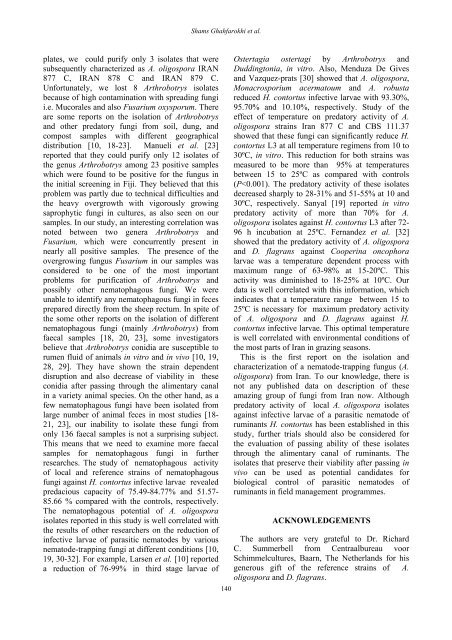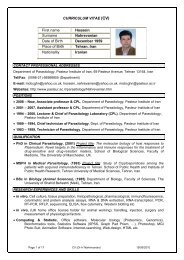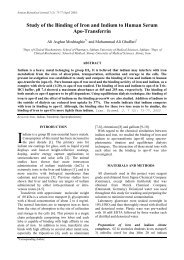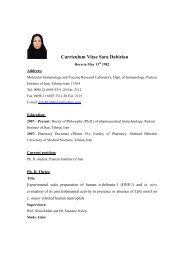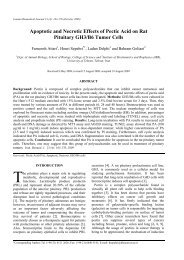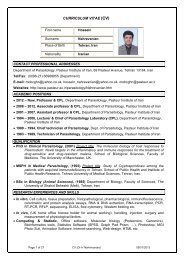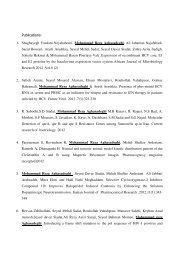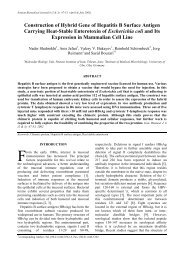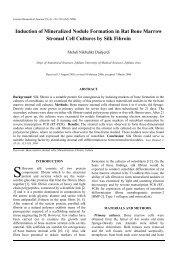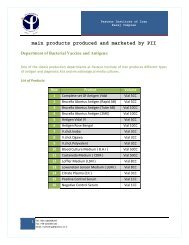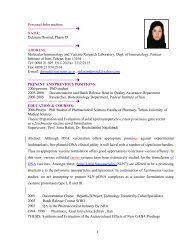Screening of Soil and Sheep Faecal Samples for Predacious Fungi ...
Screening of Soil and Sheep Faecal Samples for Predacious Fungi ...
Screening of Soil and Sheep Faecal Samples for Predacious Fungi ...
You also want an ePaper? Increase the reach of your titles
YUMPU automatically turns print PDFs into web optimized ePapers that Google loves.
Shams Ghahfarokhi et al.<br />
plates, we could purify only 3 isolates that were<br />
subsequently characterized as A. oligospora IRAN<br />
877 C, IRAN 878 C <strong>and</strong> IRAN 879 C.<br />
Un<strong>for</strong>tunately, we lost 8 Arthrobotrys isolates<br />
because <strong>of</strong> high contamination with spreading fungi<br />
i.e. Mucorales <strong>and</strong> also Fusarium oxysporum. There<br />
are some reports on the isolation <strong>of</strong> Arthrobotrys<br />
<strong>and</strong> other predatory fungi from soil, dung, <strong>and</strong><br />
compost samples with different geographical<br />
distribution [10, 18-23]. Manueli et al. [23]<br />
reported that they could purify only 12 isolates <strong>of</strong><br />
the genus Arthrobotrys among 23 positive samples<br />
which were found to be positive <strong>for</strong> the fungus in<br />
the initial screening in Fiji. They believed that this<br />
problem was partly due to technical difficulties <strong>and</strong><br />
the heavy overgrowth with vigorously growing<br />
saprophytic fungi in cultures, as also seen on our<br />
samples. In our study, an interesting correlation was<br />
noted between two genera Arthrobotrys <strong>and</strong><br />
Fusarium, which were concurrently present in<br />
nearly all positive samples. The presence <strong>of</strong> the<br />
overgrowing fungus Fusarium in our samples was<br />
considered to be one <strong>of</strong> the most important<br />
problems <strong>for</strong> purification <strong>of</strong> Arthrobotrys <strong>and</strong><br />
possibly other nematophagous fungi. We were<br />
unable to identify any nematophagous fungi in feces<br />
prepared directly from the sheep rectum. In spite <strong>of</strong><br />
the some other reports on the isolation <strong>of</strong> different<br />
nematophagous fungi (mainly Arthrobotrys) from<br />
faecal samples [18, 20, 23], some investigators<br />
believe that Arthrobotrys conidia are susceptible to<br />
rumen fluid <strong>of</strong> animals in vitro <strong>and</strong> in vivo [10, 19,<br />
28, 29]. They have shown the strain dependent<br />
disruption <strong>and</strong> also decrease <strong>of</strong> viability in these<br />
conidia after passing through the alimentary canal<br />
in a variety animal species. On the other h<strong>and</strong>, as a<br />
few nematophagous fungi have been isolated from<br />
large number <strong>of</strong> animal feces in most studies [18-<br />
21, 23], our inability to isolate these fungi from<br />
only 136 faecal samples is not a surprising subject.<br />
This means that we need to examine more faecal<br />
samples <strong>for</strong> nematophagous fungi in further<br />
researches. The study <strong>of</strong> nematophagous activity<br />
<strong>of</strong> local <strong>and</strong> reference strains <strong>of</strong> nematophagous<br />
fungi against H. contortus infective larvae revealed<br />
predacious capacity <strong>of</strong> 75.49-84.77% <strong>and</strong> 51.57-<br />
85.66 % compared with the controls, respectively.<br />
The nematophagous potential <strong>of</strong> A. oligospora<br />
isolates reported in this study is well correlated with<br />
the results <strong>of</strong> other researchers on the reduction <strong>of</strong><br />
infective larvae <strong>of</strong> parasitic nematodes by various<br />
nematode-trapping fungi at different conditions [10,<br />
19, 30-32]. For example, Larsen et al. [10] reported<br />
a reduction <strong>of</strong> 76-99% in third stage larvae <strong>of</strong><br />
140<br />
Ostertagia ostertagi by Arthrobotrys <strong>and</strong><br />
Duddingtonia, in vitro. Also, Menduza De Gives<br />
<strong>and</strong> Vazquez-prats [30] showed that A. oligospora,<br />
Monacrosporium acermatoum <strong>and</strong> A. robusta<br />
reduced H. contortus infective larvae with 93.30%,<br />
95.70% <strong>and</strong> 10.10%, respectively. Study <strong>of</strong> the<br />
effect <strong>of</strong> temperature on predatory activity <strong>of</strong> A.<br />
oligospora strains Iran 877 C <strong>and</strong> CBS 111.37<br />
showed that these fungi can significantly reduce H.<br />
contortus L3 at all temperature regimens from 10 to<br />
30ºC, in vitro. This reduction <strong>for</strong> both strains was<br />
measured to be more than 95% at temperatures<br />
between 15 to 25ºC as compared with controls<br />
(P


